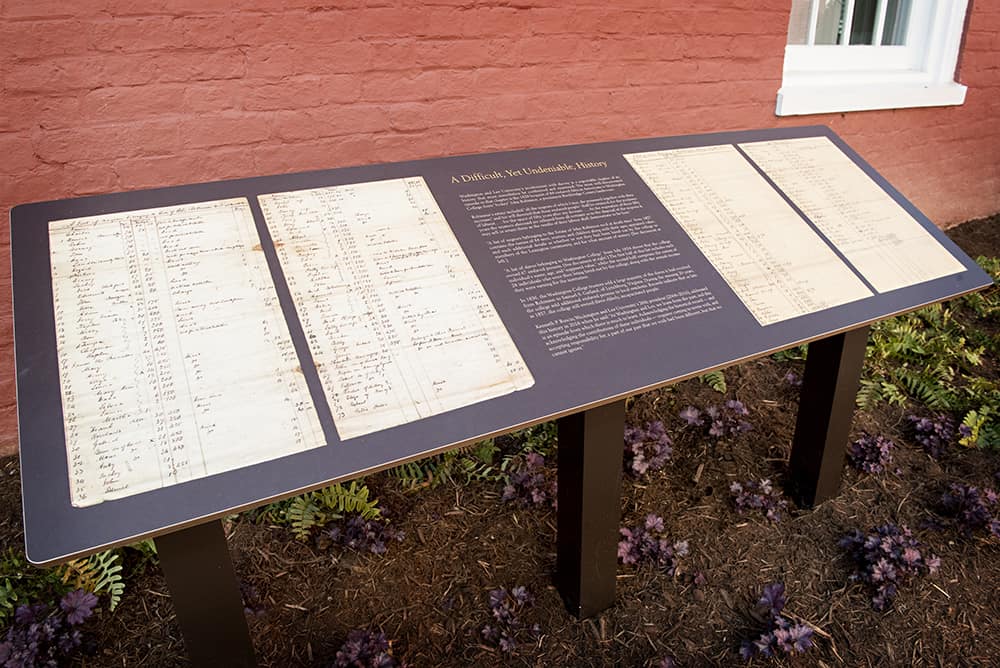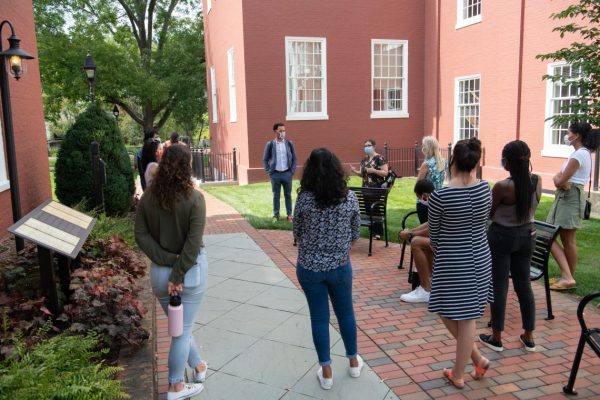
Examining Our Past: Critical Race Theory Class Visits Campus Historical Marker
Members of the Critical Race Theory class at W&L Law recently took a short field trip “across the ravine” to meet with Dr. Lynn Rainville, director of institutional history, for a discussion about the University’s ties to slavery.
One stop on the tour was the historical marker outside Chavis Hall, formerly known as Robinson Hall. Installed in 2016, the marker documents the enslaved men and women that Washington College inherited from John Robinson, owned and then sold. That marker, “A Difficult, Yet Undeniable, History,” displays the names of these people as they were recorded in the minutes of the institution’s trustees.
Dr. Rainville leads such tours at W&L for many classes on a wide range of topics involving institutional history and much more.
“In my first year as the inaugural director of institutional history, I gave tours and talks on our geology program, women’s history, Lee House, the plaques in Lee Chapel, our historic buildings, old graveyards, past presidents, ghosts, and native peoples in Rockbridge County,” said Rainville. “As with the Critical Race Theory class, I tailor the presentation to the syllabus and always solicit student questions.”
These presentations have resulted in students seeking her assistance with additional research into various historic eras, issues related to memory and commemoration, desegregation, the role of student organizations, veterans, and W&L traditions.
The Critical Race Theory class, taught by Professor Brandon Hasbrouck, examines the institutionalization of racism in the development of American law. It explores the development of critical race theory, investigates the uses and meanings of race in U.S. legal institutions and ideology, and maps the connections between critical race theory and broader national debates about race, racism and racial justice.
One student in the class, Luis Inarra Rojas ’22L, reflected on the experience of visiting the marker. “It was inspiring to see and hear my fellow students refuse to succumb to fear and continue to demonstrate why our student-body is like no other by asking critical questions about the value of slave labor to W&L’s development as an elite academic institution,” said Inarra Rojas.
“I may forget the prima facie elements of negligence in two years, but the pain and frustration from this discussion will stay with me for the rest of my days,” he added.
Hasbrouck, who is also an alumnus, is one of the most vocal proponents urging the University to examine its history and ties to slavery, and the University grounds serve as an excellent resource to bring a historical lens to his teaching and research. Although Hasbrouck knew the University owned enslaved Black families, he learned on the tour himself for the first time that these families were separated when the University sold them, in violation of John Robinson’s will.
“We need to confront this history. Engage in truth and reconciliation. Understand that this institution was built on the backs of Blacks, which included the sale of Black people,” said Hasbrouck.
 Dr. Lynn Rainville discusses the University’s ties to slavery with Prof. Brandon Hasbrouck’s critical race theory class.
Dr. Lynn Rainville discusses the University’s ties to slavery with Prof. Brandon Hasbrouck’s critical race theory class.
You must be logged in to post a comment.